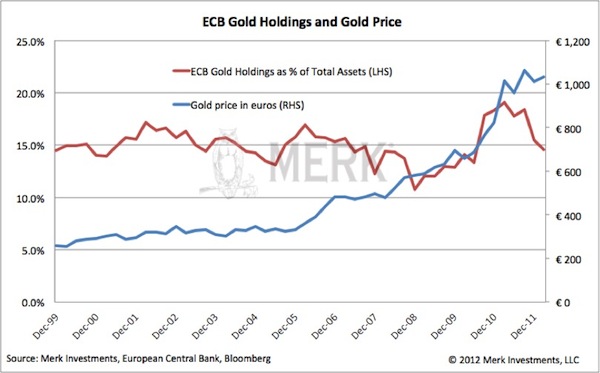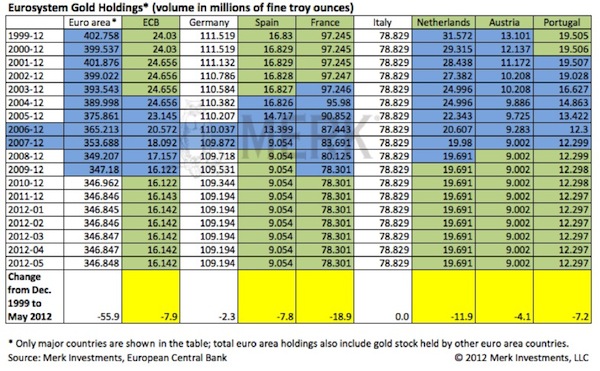Axel Merk published his latest Merk Insights entitled "Spain's Molasses Jeopardizing Eurozone?!". He analyzed the debt structure in Spain, and explains that just shuffling debts around won't fix the debt problem, and guarantees must be removed to solve over-indebtedness. Failing to do so will make the global financial system as a whole at risk.
Here's the full commentary:
Spain's regional government debt is in focus again. Spanish 10-year
government bond yields are trading near 7.5% as Spain’s central
government is expected to bail out its regions – and in return may ask
for a bailout itself. Guarantees don’t make a system safer, quite the
opposite: everything is safe until the guarantor itself is deemed
unsafe. While the failure of any one business of regional government is a
tragedy, providing a guarantee puts the system as a whole at risk.
Spain consists of 17 autonomous regions, whose total debt
almost doubled in the past three years. Technically, Spanish law forbids
the central government from rescuing regional government (in much the
same way that the Maastricht Treaty prohibits bailouts of EU countries).
The debate on whether the central government should take more control
over regional budgets and provide guarantees/bailouts has intensified
since January, when the central government implicitly helped Valencia,
one of the most indebted regions, with a €123 million loan repayment to
Deutsche Bank:
- Though the central government is prohibited from rescuing
regional governments and it denied it has done so, El Pais (Spain's
highest-circulation daily newspaper) reported earlier this year that the
Spanish Treasury provided implicit guarantee and help to Valencia in
repaying the loan to Deutsche Bank. The central government advanced its
regular transfers to Valencia by about 10 days to January 3rd. On the
next day, Jan. 4th, Valencia was reported to have repaid the loan. It
can be viewed as the first implicit bailout from the central government
in Spain.
In an effort to impose more control over the spending of
regional governments, the Spanish Council of Ministers approved a draft
of a Stability and Sustainability Law in late January; one provision is
that the central government could oversee the budgets of the 17
autonomous regions and establish penalties for those who do not meet the
balanced budget targets (all regions missed the deficit-to-GDP target
of 1.5% last year). Not surprisingly, the provision created strong
controversy. Socialist-led regions (i.e. Catalonia) criticized the
provision harshly, while some conservative-ruled regions (i.e. Valencia)
backed the plan. The criticism didn’t stop Catalonia to ask for delays
in handing tax payments to the central government.
In May, in a clear sign that troubles for the regions were
escalating, Valencia, one of the most troubled regions, was forced to
pay what was considered a punitive 6.8% yield to roll over €500 million
for six months, more than six times the Spanish Treasury had to pay on
the comparable-maturity at the time. By now, the yields have further
risen to around 20%.
A highly decentralized budget system
- Spain is divided into 17 autonomous regions due to historical reasons and cultural differences.
- Regional governments have historically been granted
significant control over spending. They take charge of education, health
and social services, which account for 50% of total government
expenditures.
- Regions also have the power to authorize or veto the issuance of public debt.
- The central government has little ability to interfere
regional government spending, but is prohibited by Spanish law to
bailout regional governments.
Mismatch in regional fiscal autonomy
- While regions enjoy high autonomy on spending, the
central government retains effective control over regional government
revenue.
- For 15 out of the 17 regions, the central government
retains all powers over the collection and regulation of important taxes
(i.e. corporate income tax, import duties, payroll taxes). Regional
government revenues mainly come from the central government's
conditional grants and ceded taxes (set at central level, but collected
at regional level). Central grants vary from year to year; they are
designed to address regional imbalances. And for some of the ceded
taxes, these regions only retain a small share (i.e. 35% for VAT and 50%
for personal income tax) after collection.
- Only two regions are close to the maximum fiscal
autonomy. They have full powers over a number of major taxes and retain
100% of ceded taxes.
Regional debt accumulation
- As a result of the economic recession and housing market
collapse, all 17 regions experienced a significant rise in debt. By
2011, the total debt of 17 regional governments rose to €140 billion,
accounting for 13.1% of Spain's GDP. This number is up from 6.7% by
2008.
- 10 out of 17 regions' debt-to-regional-GDP ratio exceeded
10% (versus 2 out 17 by 2008). All regions missed the deficit-to-GDP
target of 1.5% last year.
- The most indebted region, Catalonia, recorded a 20.7%
debt-to-regional-GDP ratio and 3.6% deficit-to-GDP ratio in 2011.
Catalonia’s 10-year bond yield exceeded 14% at its peak in June.
- The 2nd indebted region, Valencia, delayed repayment of a
€123 million loan to Deutsche Bank in January. Subsequently, the
region's credit rating was downgraded by Moody's to junk and it failed
to raise €1.8 billion in a bond auction in March. Valencia is a
Mediterranean region with many beach-front properties; its economy
collapsed after the housing bubble bust.
Last Friday, Valencia was the first region to say it would
contribute into a new Spanish government fund to meet its
debt-refinancing obligations, as well as to pay suppliers. With that,
the Spanish government is now clearly on the hook for the regions’ debt.
Not surprisingly, the market is pricing in that reality. Trouble is
that Spain’s central government does not have the credibility that it
has sufficient influence to turn the regions’ finances around. Unless
the Spanish government can assure the markets that it can deliver
sustainable budgets – for itself and now the regions as well – it will
simply go deeper into the molasses and risks taking the Eurozone with
it. And while Spain certainly tries to advance its structural reform,
the headlines coming out from the region suggest Spain might be more
interested in the European Central Bank (ECB) intervening to help out
Spain’s cost of borrowing. As long as debt is merely shuffled around,
the Eurozone crisis won’t be solved. And as long as ever more guarantees
are provided – from regional to national governments, from
supranational issuers such as the European Stability Mechanism (ESM) to
the International Monetary Fund, the more the global financial system as
a whole may be at risk.




